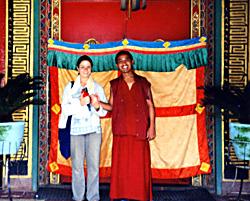Finding Tibet in the Heart of Nepal

“You must leave your shoes at the door,” Tenzin told me. Slipping off my flip-flops, I followed him into the hall. “You will come here everyday for puja,” he said, as if I had been chosen, but, in reality, it was I who had done the choosing. I already had visited eight monasteries in India, and now I was here, at Sakya Thaig Gonpa, a monastery in Nepal. I liked the friendliness of these monks. Yes, I decided. This was where I would conduct my research into the musical form and function of Tibetan Buddhism.
It was a good choice. The monks opened the doors of an all male institution to me, an American female student with a notebook, microphone, and tape recorder. I arrived at the monastery at about 5:45 every morning (except Saturday) to attend their morning puja, a ritual ceremony. After that came school for the younger monks and elaborate pujas that older monks performed as offerings to peaceful and protector deities. I sat in a corner and listened, took notes, and recorded their rituals.
That’s how I spent much of the summer between my junior and senior year, thanks to funding from the International Research Opportunities Program (IROP) and support from friends and teachers. Because of my long-term interest in Tibet and my admiration for the Tibetan culture, the IROP experience was the perfect opportunity for me to expand my academic horizons.
It took nine months to plan the trip, and finding a location for my project proved the greatest obstacle. Since the Chinese invasion in 1959, Tibetans have fled their country into exile in India and Nepal. If I wanted to study the music of Tibetan Buddhism, I had two options: one, a country ready to go to war over a border conflict, the other a monarchy dealing with rebel threats and a heightened fear of civil war. My initial destination was the far eastern tea plantations of Darjeeling, but after a U.S. State Department announcement advised all Americans to leave India, I headed to Kathmandu, a sub-tropical hot-zone in southern Nepal.
Kathmandu is a chaotic metropolis with millions of cars, and one stoplight. It has no landfills or septic systems, and garbage is burned in the streets. Nepal is the only declared Hindu nation in the world, so, as the vessels who lead you to heaven, cows have the right of way in traffic. I lived in the stupa Boudhanath, a sanctuary from the cow-caused traffic jams, the deadly fumes of blazing garbage, and open sewers. The Boudhanath stupa is a large Buddhist monument possessing the eyes of the Buddha. Built around the massive structure are dozens of re-built Tibetan monasteries that were founded by high lamas who went into exile after the Chinese destroyed all but seven of the 6,000 monasteries in Tibet.
Although the majority of my time was spent in the monastery, I was able to experience other aspects of life in Nepal. I took dramyen lessons (Tibetan lute) from a renowned musician. I worked at an orphanage for Nepali children from the remote district of Dolpa. And I taught English to Tibetan refugees, which at first made me apprehensive. A colonialist notion, I felt, teaching English to these people. But one Tibetan monk explained “We must tell the world about our situation, but how can we do that in Tibetan? No one will understand.” So, I taught them how to write letters to politicians and possible sponsors.
Right now, the whole world seems to be concerned with war, yet in Boudhanath, where religion is so interconnected with life (as though it were food or water) and war is of little concern. Even as Maoist rebels bomb the Nepalese, this stupa serves as a sanctuary from hatred. Inspired by the words of His Holiness the 14th Dalai Lama and the peaceful teachings of the Buddha, Tibetans maintain a non-violent struggle and peaceful outlook. There is little, one Tibetan woman explained to me, that divides us as human beings. “Do you not desire food, clothing, and warmth?” she asked. “All beings shudder before death, and if everyone kept this in mind there would be less violence in the world.” It seems so simple, I thought.
--Jessie Wallner ‘03